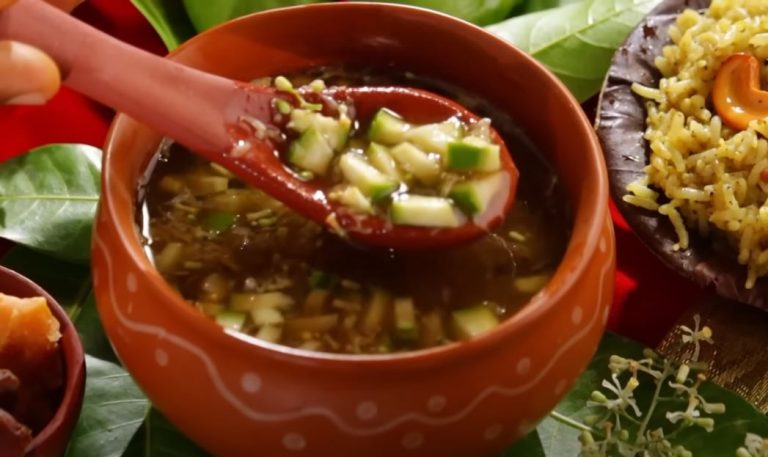More than just calendar adjustments are involved in celebrating Ugadi, the South Indian New Year, which serves as a stark reminder of the range of emotions that exist in life. The centerpiece of this celebration is the Ugadi Pachadi, a highly adaptable mixture of six distinctively symbolic flavors. These flavors—which are markedly enhanced when carefully blended—reflect the range of emotions found in life, from joy and astonishment to sorrow and terror.
Ugadi Pachadi, which is traditionally prepared with jaggery, neem flowers, tamarind, raw mangoes, black pepper, and salt, is remarkably successful at balancing taste and tradition. Each ingredient represents a distinct emotional nuance, strikingly similar to the unpredictable nature of life. For example, the bitterness of neem poignantly highlights life’s inevitable sorrows, while sweet jaggery symbolizes joy.
| Ugadi Pachadi Information | Details |
|---|---|
| Ingredients | Neem flowers, raw mango, jaggery, black pepper, tamarind, salt |
| Festival Significance | Represents six tastes symbolizing life’s emotions |
| Dietary Suitability | Vegan, Gluten-Free |
| Preparation Time | Approximately 15 minutes |
| Authentic Recipe Source | Swasthi’s Recipes |
Developing Your Skills in Ugadi Pachadi Preparation
There has been a noticeable shift in culinary traditions in recent years toward quick recipes. The Ugadi Pachadi, on the other hand, continues to be incredibly inventive, maintaining its profound symbolism and simplicity. To make this festive drink, begin by soaking a small amount of tamarind pulp in warm water, and after about half an hour, gently extract its tangy essence.
After that, add the finely chopped jaggery and stir it into the tamarind water until it dissolves completely. After that, add the raw mangoes, freshly picked neem flowers, salt, and a dash of black pepper, carefully blending to combine. This beverage, which is much quicker to make than most festive dishes, has great cultural significance and emphasizes the complexity of life.
Creative Ways to Replace Ingredients in International Kitchens
Finding neem flowers can be very inconvenient for people who live outside of India, so substitutes are especially helpful. Fenugreek powder or overnight-soaked fenugreek seeds are very dependable alternatives that maintain the dish’s symbolic bitterness. In a similar vein, green chilies can be used in place of traditional black pepper, which works very well in this recipe. This allows you to adjust the heat level to your liking.
Even the most remote kitchen can preserve Ugadi Pachadi’s authenticity and emotional impact by making thoughtful substitutions. Adapting recipes to local conditions is like navigating life’s unexpected detours: both require creativity and resilience, as my grandmother used to say.
The Rich Significance of Each Flavor
Each ingredient has symbolic meaning that is ingrained in cultural wisdom in addition to its culinary appeal. Neem’s bitterness, which represents life’s hardships, stands in stark contrast to jaggery’s sweetness, which symbolizes happiness. Raw mango adds tanginess, while the sour notes of tamarind recall life’s occasional setbacks—a subtle homage to life’s unexpected surprises.
While black pepper’s fiery heat eloquently represents rage and intensity, salt emphasizes the fear and anxiety that are a part of human life. Through the integration of these disparate flavors, Ugadi Pachadi teaches metaphorically that the richness of life is found in accepting rather than avoiding its contradictory experiences.
Bringing Communities Together Through Tasty Tradition
Family kitchens become lively hubs of activity that bustle like a festive marketplace during Ugadi celebrations. Family ties are greatly strengthened as the preparation of Ugadi Pachadi itself turns into a time for storytelling and camaraderie. Communities strengthen their shared values and aspirations for the upcoming year by sharing a taste of this treat.
The power of food as a universal language has been demonstrated by the notable increase in interest in traditional recipes like Ugadi Pachadi over the past ten years. By actively engaging in these customs, younger generations greatly strengthen their sense of identity and establish a meaningful connection with their cultural heritage.

Introspection: The Significance of Ugadi Pachadi
It can be very difficult for medium-sized communities overseas to continue celebrating traditions. However, foods like Ugadi Pachadi provide concrete ties to culture, arousing strong feelings of nostalgia and emotional satisfaction. I still clearly recall my first Ugadi spent away from home, when making this dish made me feel much less alone.
Making Ugadi Pachadi serves as a reminder that life, despite its occasional bitterness, is overwhelmingly sweet when shared, much like the recipe’s call for balancing various flavors. By preserving customs through culinary practices, we fortify our bonds—making each new year incredibly successful in reviving our souls.
FAQs for Ugadi Pachadi Recipe:
Q1: What is Ugadi Pachadi traditionally made of?
A: It’s made of neem flowers, raw mango, jaggery, tamarind, black pepper, and salt.
Q2: What does Ugadi Pachadi symbolize?
A: It symbolizes life’s diverse emotions—joy, sorrow, surprise, anger, fear, and disappointment.
Q3: Is Ugadi Pachadi vegan and gluten-free?
A: Yes, it is naturally vegan and gluten-free.
Q4: Can neem flowers be substituted in Ugadi Pachadi?
A: Yes, fenugreek seeds or powder make extremely reliable substitutes.
Q5: How long does it take to prepare Ugadi Pachadi?
A: It takes approximately 15 minutes, making it highly efficient for festive cooking.
Q6: Can I adjust ingredients according to personal taste?
A: Absolutely, ingredient quantities can be adjusted for preferred taste balance.



